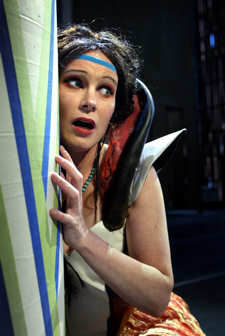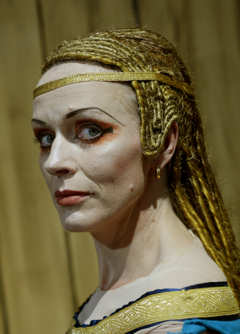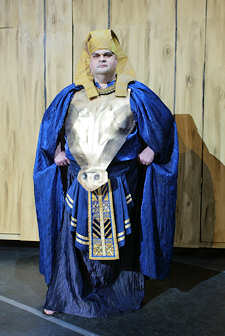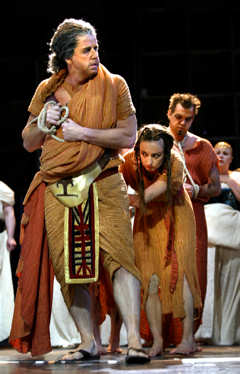Verdi:
Aida, Soloists
Bergslagen’s Music-Dramatic Chorus; Classic
Chamber Conductor: Georg LidströmOpera
på Skäret, Kopparberg, Sweden, 28.7.2007
(Premiere) (GF)
Production
Directed by Sten Niclasson
Set Design: Sven Östberg
Costumes: Karin Olebjörk
Masks: Helena Andersson
Light Design: Ronny Andersson
Cast:
Aida – Charlotta Larsson
Amneris – Anette Bod
Radames – Stuart Neill
Amonasro – Ole Jörgen Kristiansen
Ramfis – Michael Schmidberger
King – Mikael Axelsson
Messenger – Won We Choi
Priestess – Anna-Carin Niclasson
Dancers – Ulriqa Fernqvist, Sara Suneson, Peter
Svenzon
Bergslagen’s Music-Dramatic Chorus; Classic
Chamber Conductor: Georg Lidström

Aida :Charlotta Larsson
Deep in the dark spruce forests in central Sweden,
some 200 kilometres north-west of Stockholm, on
the northern end of Lake Ljusnaren, an enormous
red, wooden building towers above the surrounding
houses. Once it was a saw-mill, but it closed down
and today it is transformed into probably the most
unique opera house in the country. “Skäret” (The
Skerry) is the name of the little village nearby
and “Opera på Skäret” (Opera on the Skerry) is a
summer festival held in these beautiful
surroundings for some years now. It was opera
singer and director Sten Niclasson who found the
place a decade ago and had a vision, though in
this case it didn’t remain a vision only. Sten
Niclasson managed to get the local and regional
authorities interested in the project, a
foundation was created, the University of Örebro
became involved and through donations and sponsors
funds were raised that made it possible to buy the
property. A first test concert was carried through
in 1999 and in 2003 the first festival was held,
including a master class for young singers in
collaboration with the College of Music in Örebro.
In 2005 there were three concert performances of
La traviata, last year the first complete
own production, Rigoletto, was performed
six times and this year there are two different
productions: a recently rediscovered 18th
century comic opera and Verdi’s Aida, which
will be given ten times until 19th August.

Amneris: Anette Bod
The auditorium is high, long and fairly narrow,
the atmosphere airy: one can even see the
surrounding nature through the openings between
the boards of the walls, so it is in fact a
half-and-half outdoor event. But contrary to
Dalhalla, 200 kilometres northwards, one is
protected from rain and on the premiere afternoon
a short but violent downpour rattled intensely
against the roof and managed to drench the
pianissimo opening of the prelude. If this was bad
timing, the opposite occurred during the short
change of scene between Act III and 4IV, when what
seemed like the world’s longest freight train
thundered by on the railway that runs only 50
metres from the opera house!
The auditorium seats 800 visitors. The chairs –
very comfortable and beautiful! – in the stalls
are placed directly on the floor and since the
stage is fairly low that means that people seated
in the rear part of the stalls sometimes have
difficulties in seeing the action. I think this
can, at least partly, be solved by placing the
chairs zigzag instead of straight behind each
other. The stage is rather narrow, which can be a
hampering factor when staging a monumental opera
like Aida with its mass-scenes, but in
practice it worked splendidly. It is like the
difference between a hardback novel and the
paperback version: the same text but smaller
print. The sets were simple but efficient: two
enormous wooden gates that could be opened and
closed for different purposes, a high column to
the left suggesting the Egyptian setting, an Isis
statue to the right. During the third act’s Nile
scene, the moonbeams glittering on the water was
reflected on the gates and there were other
examples of clever lighting. As I said: simple but
efficient, leaving to the on-lookers’ imaginations
to fill in the rest. The costumes further placed
the action where it should rightly be: in ancient
Egypt.

Radames: Stuart NeillThe action was in the main rather sparse and even
statuesque, especially in the first two acts. On
the other hand there is very little overtly
dramatic that happens there – the drama doesn’t
catch fire until Act III and the driving force
there was Amonasro, sung and acted with enormous
intensity and stage presence by Ole Jörgen
Kristiansen. The three dancers contributed
strongly to heighten the tension in the first two
acts and especially Peter Svenzon who offered a
virtuoso show in Act 2, accompanied by delighted
screams from the ladies of the chorus. I was quite
impressed by the chorus, who are not professionals
but did a splendid job. Of course Sweden is a
country abounding with choral singers; more than
one million, out of a population of less than nine
million, regularly sing in one or more choirs.
They were well balanced, sang in tune and what was
lacking in sheer force – which an opera chorus
would have produced – was more than compensated by
the homogeneity of sound. The experienced Georg
Lidström led his fine orchestra with both
sensitivity and power and there were many finely
executed instrumental solos, of which the English
horn, very exposed during Aida’s Nile aria and on
the whole in much of the third act,should be
mentioned . There isn’t room for a full-size
orchestra at Skäret, neither financially nor
space-wise, which is a pity in this opera, where
so much important happens in the string section,
especially in the high violins, and a handful of
further players wouldn’t have come amiss. The
almost inaudible opening of the prelude was of
course ruined anyway by that unfortunate shower of
rain but it’s the same situation in the Nile scene
and elsewhere. This is no real criticism though,
rather a statement, and throughout the
performance the playing was admirable with a
really punchy Triumphal scene with the Aida
trumpets on stage ringing out gloriously.

Amonasro: Ole Jörgen Kristiansen
Turning now to the singers, the star of the cast
should of course be American tenor Stuart Neill,
with an international career that has taken him to
many of the leading opera houses of the world,
including the Metropolitan, Teatro alla Scala in
Milan, Paris and Covent Garden. He had a somewhat
shaky start – his Celeste Aida was well
conceived but he was rather wobbly; it wasn’t very
kind of Verdi to have the tenor sing this testing
piece so early in the performance! Soon he
settled, however, and in the third act he was both
vocally and dramatically formidable. He has a
large voice, quite baritonal in timbre, but with
gleaming top notes cutting through even the
thickest orchestral fabric. Occasionally I had a
feeling that he sacrificed sensitivity to show off
his forte, but he made amends in the final scene,
the Tomb duet with Aida, where he scaled down the
histrionics and sang sincerely with lyrical
restraint and beautiful head tone, only to end the
duet on a weightless pianissimo. This was great
singing, indeed!
His Aida, Charlotta Larsson, has primarily sung
lyric roles but she was ravishing in this role
too. True, it is a lyrical voice but to be
a successful Aida one needs to be youthful, both
in voice and appearance. She was both and she was
powerful enough to make the fortes ring out with
brilliance. Her only weakness was the lowest
register, which didn’t quite carry out over the
orchestra. She sang both her arias with great care
for nuances, and especially in the Nile aria, O
Patria mia, she mustered impressive dramatic
power – without going over the top. Beautiful and
impassioned singing of the highest order.
I have already mentioned her father Amonasro’s
dramatic potential but Ole Jörgen Kristiansen also
impressed through his pure singing. His baritone
voice is large enough to challenge even Stuart
Neill for sheer volume, but it is also warm in
tone and he has an impressive legato, which
he showed in one of the most beautiful passages in
the whole opera, his solo in the second act, where
the phrase Ma tu, Re, tu signore possente
was rendered with a heartfelt lightening of tone.
Anette Bod as Amneris, didn’t have one of her
better days. From the outset she felt small scale
and sang with a pronounced wobble. Not until the
last act and the scene with Radames did she get
her voice in check. It is a vibrant voice but this
is more or less part and parcel for the role and
she seemed to have gained in volume too. Anyway,
this was one of the more thrilling scenes in the
performance. In the lowest department both Michael
Schmidberger as Ramfis and Mikael Axelsson as the
King made honourable achievements, Anna-Carin
Niclasson was a good Priestess and Won We Choi
sported an impressively voluminous and beautiful
voice in the small role as a Messenger, a role
normally taken by a comprimario or even
someone from the chorus. It turned out, however,
that this Korean tenor also is substitute for
Radames, which says something about his capacity.
Besides everything else I was deeply impressed by
the lavishly illustrated 48 page programme book
with artists’ profiles, a good essay on Aida,
a very detailed synopsis and the history of Skäret,
among other things. This was my first visit to
Skäret and I will certainly return next year, when
Mozart’s Die Zauberflöte is scheduled.
Göran Forsling
Photos: Petter Koubek
Website:
www.operapaskaret.se
Back
to the Top
Back to the Index Page

